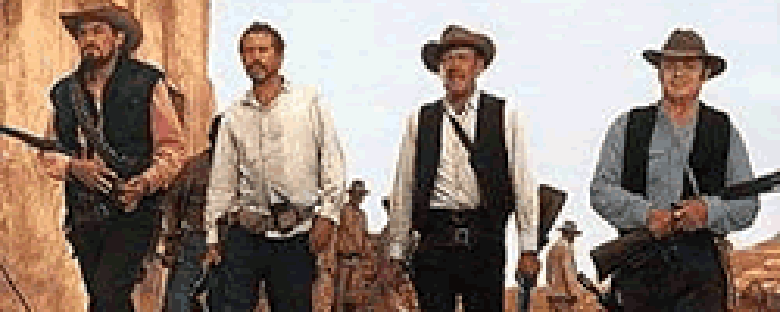Reviews
Sam Peckinpah
USA, 1969
Credits
Review by Rumsey Taylor
Posted on 11 July 2004
Source Warner Bros. VHS (uncut, letterbox edition)
As the men that comprise Sam Peckinpah’s Wild Bunch ride in to a southern Texas railroad town, they pass a group of children on the town’s outskirt. The view is distracted, and highlights the kids’ object of fascination: a scorpion trapped within a swarm of ants. The children laugh and smile (freeze frames are careful to display their emotion), place hay atop their miniature arena and light it on fire.
It is a classic opening in a classic Western. It is also a thematic microcosm that foreshadows two particular scenes in the film, for contrary reasons. Firstly, in the opening shootout, the bunch places innocent pedestrians at the whim of their active weapons, much like the children with little care for the scorpions they have endangered. Second, as the film’s brutal finale will display, the bunch will meet their fate trapped in a swarm of enemies — each individually diminutive in comparison and stronger in sum. The comment, here, is deliberately impeded by its double-meaning; the titular group may be either domineering (heroic, even) or victimized.
The Wild Bunch depicts activity at the Texas-Mexico border immediately prior to the Mexican Revolution in 1914. The Western’s (a genre the film inhabits by default) most specific trait is the lone cowboy — the individualist, a trait altogether excluded in this film. In favor are the corruptive, unstable politics of collaborative crime. Finally, The Wild Bunch provides a logical transition (though, released after Bonnie and Clyde, it occurs out of sequence) to the contemporary gangster film. Westerns are attitudes, threats, and rewards — The Wild Bunch does not highlight these genre traits, and replaces them with a violence unparalleled in the genre’s other entries; it is Sam Peckinpah’s trademark punch, and The Wild Bunch is his showcase.
During the film’s opening robbery, a team of snipers outnumbers the bunch atop roofs that surround the targeted bank. It is a complex staging that Peckinpah does well to choreograph. Bullets fly in chaos, and Peckinpah is careful to detail each action, each landed hit. He makes noticeable interspersions of slow-motion footage, as when a sniper atop a roof is shot, and falls slowly in between shots of quicker-paced action. There is a distinct technical construction to this and other scenes. It is a point of controversy consistent within Peckinpah’s catalogue; the actions, drama, and plight of his gunmen are sympathized and their deaths exploited (in slow motion, of course) with obsessive and even perverse curiosity. His eye for masochism seems dated, today, for the volume of films Peckinpah has stylistically influenced.
This notion of directorial masochism, which I use without hesitance here and in my review of Straw Dogs, is endorsed by Peckinpah’s credit for this film. It opens in an iconic manner: as each in the group rides in and passes the frame individually, the view freezes and displays, additionally, their screen credit (this is followed by credits for the crew). The credits culminate with Peckinpah’s, following the first line spoken by the group’s leader Pike: “If they move, kill “em!” (Pike is addressing his men in regard to the bank’s hostages.) The line is, also and unsubtly, a direction, or particularly, a violent threat. It is a line that references Peckinpah’s role, as his direction is responsible for the film’s violence.
Aside from its violence, which continually (and justifiably) encounters discussion, The Wild Bunch excels in other aspects of its design. Every exterior scene, it seems, finds an untouched spot of sand interrupted by a train of horses. The film contains much unsubtitled Spanish, and dialogue is delivered in heavy jargon. It is colloquial and wholly authentic (every principle character seems to have a scar with a history). As a means of forwarding its authenticity, many of the principle characters bear aged, wrinkled skin and graying hair that impart experience. This denotes the film’s theme of transition or replacement (the threat of technology is imminent in the film, as well as the group’s end). Theirs is a dying profession, here, on its final legs.
The final shootout is an effort to rescue a captured member (Angel, the group’s runt), and it is preceded by an uninterrupted shot of the remaining four men as they proceed towards the locale that will house their deaths. The soundtrack is silent, and each routinely fills the two barrels of his shotgun. The shot is encapsulating and anticipatory. It platforms bravery, yet, it can be noted, the men’s reasoning for engaging the doomed shootout is questionable and under-thought. The distinguishing reason for the battle is camaraderie, yet there is also the implication that the bunch has nothing left to do, fearing a lack of action, violence, and purpose imminent in their uncertain futures. A pan completes the sequence, finding the anonymous corpses that strew the location. We recognize the members of the Bunch among them, dead, frozen like honored statues clutching still onto their loaded weapons.
The film’s ending, in which a surviving leader of the group rides off with another, is poetic, but it is also depressing. As the final train of horsemen is consumed in a trail of dust, images recur of the deceased members of the group engaged in laughter. It makes the suggestion that their dying actions are desperately heroic.
We don’t do comments anymore, but you may contact us here or find us on Twitter or Facebook.



